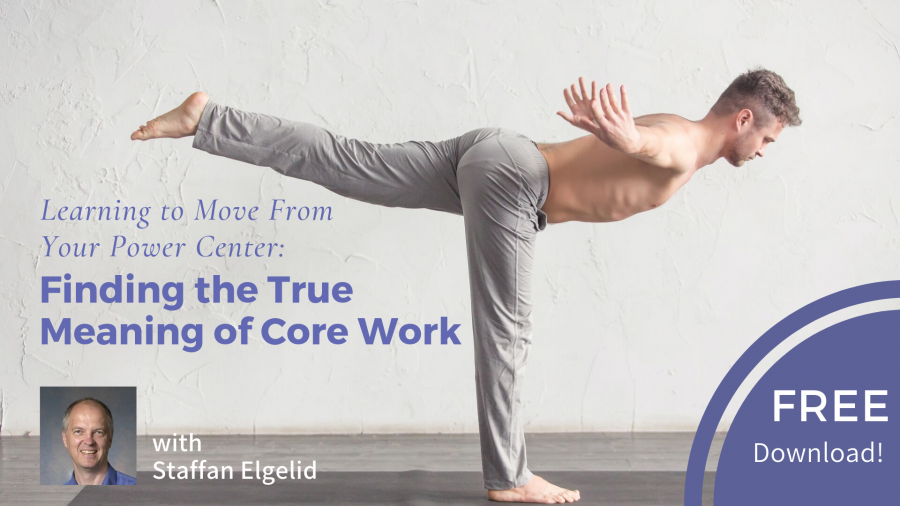Free Download! Learning to Move From Your Power Center: Finding the True Meaning of Core Work
Course Info
- Price:
- $0.00
Dr Staffan Elgelid
 Dr. Staffan Elgelid PT, PhD, GCFP, RYT-500 is an Associate Professor of Physical Therapy at Nazareth College in Rochester NY. Staffan is a Physical Therapist, Certified Feldenkrais Practitioner and Yoga Therapist. He teaches in yoga therapy programs, conducts workshops nationally and...
Dr. Staffan Elgelid PT, PhD, GCFP, RYT-500 is an Associate Professor of Physical Therapy at Nazareth College in Rochester NY. Staffan is a Physical Therapist, Certified Feldenkrais Practitioner and Yoga Therapist. He teaches in yoga therapy programs, conducts workshops nationally and... 
Throughout history, various traditions of natural healing or martial arts have emphasized the importance of the center of the body. Whether called hara, tan tien – or in today’s language, the core, we have always talked about the center of the body as an important power center of the body.
“The core is where some of our bigger muscles are,” says Staffan Elgelid, a yoga therapist, physical therapist, and Feldenkrais practitioner, and a member of the Yoga Alliance Board of Directors in this free download.
“But not only that, if you look anatomically, a lot of our movements should originate from there. Also, if you breathe correctly, there's a movement in the deep elements of the core, i.e. the the pelvic floor as well as the diaphragm. And importantly, all the organs are in between there as well. That's also part of the core.”
In this talk, Staffan points out that in yoga, true core work is much more nuanced than simply drawing in muscles or working with a single muscle group to get those vaunted six-pack abs.
“Core work is really about learning to move from this center of power in your body,” he notes. “However, there's been more of a focus on how you look than how efficient you are with your movements. Reeducation of movement patterns is really what we should be dealing with.”
“We think we can isolate muscles, but the brain doesn't think in muscles; The brain thinks in movement patterns,” Staffan further explains. “You don't have a biceps in your brain, so the whole idea that we can isolate certain muscles is very simplistic and nice, but it has nothing to do with reality. That thinking results in us overworking certain muscles that are not built for the kind of work that we want to do.”
As with all other aspects of yoga, developing an efficient and resilient core requires organically moving from the center, with awareness of breath and rooted by the spine. But importantly, we’re also practicing to regulate our nervous systems up and down, coming into and out of the familiar and comfortable.
“When we activate a little bit more in certain areas or deactivate certain areas, we get more efficient movement. If I look at the spine, for example, the big muscles might span 10 or 15 vertebra. Well, that's not very specific work,” Staffan points out. “If instead we do some smaller movements and use the muscles that will only spend one or two or three vertebra, then we get more precise movements. So it's not let one muscle work and the other one takes a vacation. That just doesn't work.”
Staffan explains the theory behind his method called, “Smart Core,” where we consciously practice to bring the spine both into and out of neutral in all directions with control. For example, we may come into bridge pose and lift one hip higher or take it out to the side and come into balance there.
The object is to develop a place to work from–core–that is both engaged and flexible enough to efficiently transfer the force necessary to perform any movement.
This type of asana practice will be a bit of a challenge for yogis used to doing a set number of sun salutations in a certain way, or always endeavoring to work in neutral spine. But Staffan is quick to point out that we do not live in neutral spine; Our lives on and off the mat are a constant act of self-management between highs and lows.
For yogis, the question is, ‘Can you bring your awareness to the center of yourself?’ Because if you can do that, you are also centering yourself.
You may also enjoy Staffan's course, Yoga for Core Integrity: Getting an Edge with the Smart Core System.